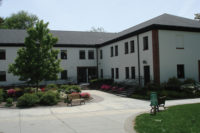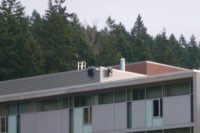When GateWay Community College’s Director of Facilities Charlie Poure originally came on board as a Maricopa County Community College District facility director, he was disheartened to discover seven buildings on the 30-acre campus outfitted with different brands of obsolete fire alarm systems and faulty wiring.
“While the fire alarms would function, we spent a tremendous amount of money trying to repair them. We actually had one building which would go into alarm about once a week because of recurring faults in the wiring,” Poure recalls.
Although it took Poure a few years to pull the funding together for a full $250,000 upgrade, he was determined to create a more secure environment for the 7,000 students and faculty on his campus.
Poure’s requirements were tough as the system had to be accessible from different buildings via multiple command centers; it had to run on something more reliable than common wire; and the entire system had to be fully addressable.
Around this same time, Ray Mulch Jr. of Aidant Fire and Security, a systems integrator based in Scottsdale, Ariz., was installing a waterless fire suppression system to protect one of the school’s critical computer and data hubs. Poure shared his dilemma regarding the current state of his fire alarm systems.
“We walked around the campus and he explained to me how he wanted a non-proprietary system that would operate from multiple buildings,” Mulch reports.
Aidant put together a proposal that successfully met Poure’s requirements and after winning the bid, installed Gamewell-FCI E3 Series® fire alarm control panels in each of the campus’s seven buildings. Although the system could have utilized the existing wire to network systems between buildings, Poure was adamant about using fiber optics for added security. Making use of the campus’s fiber optics telecommunications infrastructure, Mulch was able to network the fire alarm and ECS, saving time and expense. Even the new waterless fire suppression system was tied in and now monitored by the E3 Series system.
Local operator consoles (LOC) were installed in easily-accessible, high-traffic areas within the school’s five primary facilities. This simplistic design helped to ensure GateWay’s staff can locate an LOC quickly to send out live or pre-recorded emergency notifications to any areas within campus building(s).
Authorized facilities staff can also utilize an LOC to monitor and control the entire fire alarm and emergency communications network. Checking system status or viewing details of an event as well as temporarily shutting down specific network sections for maintenance can all be done through the LOC’s network graphic annunciator (NGA). Designed to mimic an ATM, the NGA features a customizable LED touch-screen which automatically provides real-time event details and common command options during an emergency.
Constant supervision mixed with stringent fire alarm codes were incorporated in the system to make it nearly impervious to power outages and other common faults or line breaks. Redundant communications pathways enable the network to continue operating even when one or more parts are damaged, making the fire alarm and emergency communications system more “survivable.”
Using a fire alarm system as the backbone for an ECS is a unique feature that Mulch believes adds strength to the system. “In my opinion, it’s the best solution out there because fire alarm systems are supervised so you’re adding another layer of reliability to the voice annunciation system,” Mulch states.
Although Poure’s fire alarm was meeting code requirements, he did not feel it was providing the highest level of protection, so he went the full nine yards.
“Most people just want to meet code and get the cheapest thing possible, but this facility manager wanted to do the right thing and design the best system possible. We didn’t cut any corners; we did it right,” exclaims Mulch.
To provide officials with detailed, floor-by-floor layouts of all campus buildings and major fire alarm components, along with real-time event information, the school opted to place a Gamewell-FCI FocalPoint® graphic workstation in its security office. A lengthy log of historical fire alarm event data can help facility managers troubleshoot ongoing incidents resulting from common school issues such as tampering or dirty detectors. FocalPoint’s delivery of critical system information such as the location and cause of an alarm, plus customizable graphics indicating hazardous material storage or areas of occupants requiring assistance, allow officials to quickly assess and respond to emergency incidents.
“The FocalPoint graphic workstation gives a floor plan, in color, and at a glance, one can see exactly what’s going on in the event of an alarm, as opposed to going to a digital read-out,” explains Mulch. “It basically gives a higher level of information, control and the ability to have a faster response and take action.”
CUSTOMIZABLE THREAT PROTECTION
GateWay’s fire alarm and ECS voice messaging is programmed to provide three main layers of threat protection: fire, inbound threats and on-campus criminal activity. While fire is rather straightforward, inbound threats could be a spill at a nearby chemical plant, extreme weather events or a gunman in the area.
The campus IT group may also issue alerts via e-mail and text messages — a feature the E3 Series offers as well. However, according to Poure, “There are many cases where people won’t receive such messages. For instance, if students are taking a test and their phones are off, or if staff aren’t sitting at their computers.”
Consequently, GateWay relies upon the E3 Series’ state-of-the-art speaker strobes to broadcast intelligible or crystal-clear announcements.
“While a traditional fire system gives off bells, horns and strobes, these signs are easy to ignore,” Mulch explains. “But when people receive a voice directive, they respond. High intelligibility voice evacuation is the best technology.”
Aidant also set up the system to allow zoned communication to direct announcements to one or more buildings or to the entire campus.
While some facilities choose to utilize the E3 Series ECS as a general PA system, GateWay reserves it for emergencies.
Mulch emphasizes the cost-effectiveness modular systems like the E3 Series offers. “There are so many ways to build up this particular system, that’s what’s so cool about it,” explains Mulch. “You can custom design it to the application and the client’s needs.”
From Poure’s perspective, the system’s simplicity, performance and reliability are big benefits. “The system works, it’s easy to explain and it’s easy to maintain,” he says.
PLANNING FOR THE FUTURE
Now that GateWay’s fire alarm and emergency communications system are tied together into one network, a similar system is currently in the works for Maricopa County Community College District’s Skills Center. Working again with Aidant, the plan is to put E3 Series panels into a 75,000-square-foot academic facility, a 30,000-square-foot multi-purpose building and a central plant. These three buildings will then be connected up with GateWay’s systems, allowing the community college’s 24/7 security office to monitor the three facilities’ fire alarm and ECS via the FocalPoint workstation.
In addition, GateWay is currently constructing a 122,000-square-foot building and a 17,000-square-foot facility, which will also be outfitted with E3 Series panels, bringing the campus total to nine panels. Once this is complete, Poure may also integrate a Giant Voice system to deliver intelligible voice communications in-between buildings and to expansive outdoor areas.
Meanwhile, Poure has been fielding queries from sister campuses about his new system and anticipates others to upgrade in the coming years as well.












